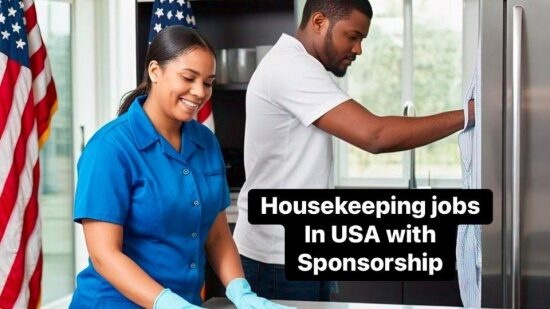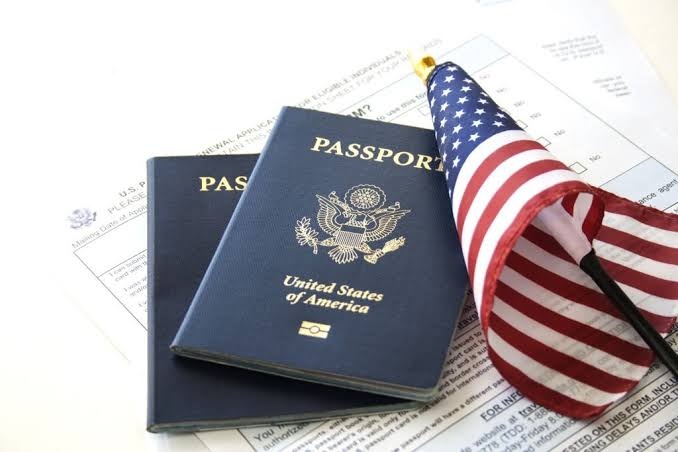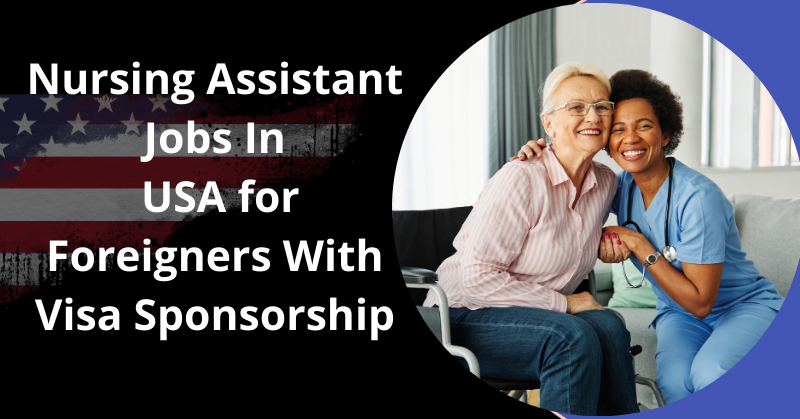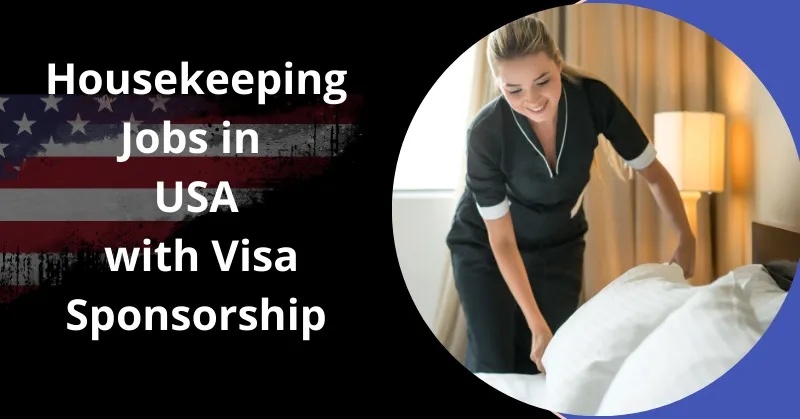In today’s global economy, the United States remains a top destination for professionals worldwide, thanks to its lucrative job market and abundant opportunities across many industries. For international candidates, landing a U.S. position that includes visa sponsorship is essential for legally working in the country. Below, we explore the landscape of U.S. jobs paying $100,000 or more that offer visa sponsorship – including key industries, prominent companies, application strategies, eligibility criteria, and other important details. These roles not only come with six-figure salaries but also the benefit of employer-sponsored visas, allowing skilled workers to build their careers in the U.S.
Understanding Visa Sponsorship in the U.S.
Common work visa categories for skilled professionals include:
Visa sponsorship is the process by which a U.S. employer petitions the government on behalf of a foreign worker to obtain permission for that individual to work in the United States. In practice, this means the company agrees to hire you and submit the necessary paperwork for a work visa. Sponsorship is critical for non-U.S. citizens who lack independent work authorization (such as a Green Card or existing work visa).
- H-1B Visa: For “specialty occupations” that require specialized knowledge and at least a bachelor’s degree (or higher). This is one of the most common visas for roles in fields like IT, engineering, and finance.
- L-1 Visa: For intracompany transferees, typically managers or employees with specialized knowledge, who are moving from an overseas branch of a company to a U.S. office of the same company.
- O-1 Visa: For individuals with extraordinary ability or achievements in their field (such as science, arts, education, business, or athletics). This visa recognizes exceptional talent and is not limited to a specific degree requirement.
Each of these visas requires the employer to sponsor the candidate. Eligibility criteria vary by visa type – for example, H-1B candidates must have at least a bachelor’s degree in a relevant field, and O-1 candidates must provide evidence of exceptional achievements – but all require a willing employer sponsor.
High-Demand Industries with $100,000+ Visa-Sponsored Jobs
Several U.S. industries are known for offering high-paying roles (often $100k or more) and are open to sponsoring work visas for international talent. Below are some in-demand job opportunities (with typical roles) that frequently provide visa sponsorship:
- Software Development (Technology): The tech sector regularly sponsors visas for software engineers and developers. Major tech companies like Amazon, Google, and Microsoft hire foreign software professionals, often through the H-1B program, with salaries well above $100,000. These roles involve designing and building software systems and can range from web and mobile app development to cloud infrastructure engineering.
- Data Science (Technology): With the rise of big data and AI, data scientists are in high demand. Companies such as Facebook and IBM offer substantial compensation packages to data analysts and scientists (frequently exceeding $100k) and will sponsor visas to secure top talent. Data roles typically involve analyzing large datasets to drive business decisions or develop machine learning models.
- Physicians and Surgeons (Healthcare): In the medical field, specialized doctors are highly sought after across the U.S. Hospitals and clinics often pay well over $100,000 for qualified physicians or surgeons and are willing to arrange work visas (for example, H-1B or J-1 for certain medical roles). These positions require relevant medical degrees, and often additional residency/fellowship training.
- Dentists and Orthodontists (Healthcare): Dental professionals can find lucrative opportunities in the U.S. with employers ready to sponsor the appropriate visas. Experienced dentists and orthodontic specialists frequently command six-figure incomes. Dental practices facing talent shortages may sponsor foreign dentists, especially if they have advanced specializations.
- Petroleum Engineers (Energy/Engineering): The energy sector (oil and gas, in particular) seeks skilled petroleum engineers to design and oversee extraction processes. Companies in this industry offer competitive salaries (often $100k+) and visa sponsorship for experts in drilling, reservoir management, and related specialties. A strong background in engineering and industry-specific knowledge is essential.
- Civil and Structural Engineers (Engineering/Infrastructure): With ongoing infrastructure development and construction projects in the U.S., there is steady demand for civil and structural engineers. Engineering firms and construction companies are often willing to sponsor visas for qualified candidates in these fields, given their specialized skills. Salaries for experienced engineers in major projects or urban development can reach or surpass $100,000.
- Financial Analysts and Managers (Finance): Investment banks, hedge funds, and financial institutions value talented financial analysts and portfolio managers. Firms like JPMorgan Chase or Goldman Sachs recruit internationally for analytical and management roles, offering attractive compensation packages. These employers commonly handle H-1B sponsorship for candidates with strong finance or quantitative backgrounds.
- Accountants and Auditors (Finance): Certified Accountants (e.g., CPAs) and skilled auditors are in demand across public accounting firms and large corporations. Many of these organizations are open to visa sponsorship to fill skilled accounting positions. With the right qualifications (such as a CPA license) and experience, salaries can hit the six-figure range, and firms will navigate work visa petitions to bring you on board.
Top Companies Offering Visa Sponsorship
Targeting companies known to sponsor foreign employees can improve your chances of finding a visa-supported job. Here are examples of notable companies (by sector) that offer visa sponsorship for high-paying roles:
- Technology: Industry-leading tech firms — including Amazon, Google, Microsoft, Apple, and IBM — are well known for hiring international talent. They regularly sponsor H-1B visas (and other visa types) for roles such as software development, data science, and product management, accompanied by competitive six-figure salaries.
- Finance: Large financial institutions like JPMorgan Chase, Goldman Sachs, and Citigroup have established programs to recruit skilled professionals globally. These banks often sponsor work visas for qualified analysts, traders, and financial managers, recognizing the value of diverse talent in roles that often pay $100k or more.
- Healthcare: Prominent healthcare employers, including major hospital systems such as the Mayo Clinic and the Cleveland Clinic, actively hire international medical professionals. They sponsor visas for physicians, specialists, and researchers who have the qualifications needed, offering high salaries commensurate with medical expertise and experience.
- Engineering/Manufacturing: Engineering-driven companies like Boeing (aerospace) and Tesla (automotive and energy) are known to sponsor visas for highly skilled engineers. These companies seek top talent in fields ranging from aerospace design to battery technology, and they provide visa support to attract qualified candidates from around the world.
(Note: Many other companies across various industries also sponsor visas. The above are just a few high-profile examples. When job searching, it helps to research whether a particular company has a history of hiring international employees.)
Strategies to Secure a Visa-Sponsored Job with a $100k+ Salary
Competition for high-paying U.S. jobs that offer visa sponsorship can be intense. Here are some strategies and application tips to improve your chances of success:
- Boost Your Qualifications: Strengthen your educational and professional profile. Consider obtaining an advanced degree (such as a Master’s or Ph.D.) in your field if possible, as U.S. employers often favor higher qualifications for top roles. Additionally, earning professional certifications relevant to your career can set you apart (for example, a CPA license for accountants or a PMP certification for project managers). These credentials signal expertise and dedication, making you a more attractive candidate to employers and immigration officials reviewing visa petitions.
- Leverage Professional Networking: Who you know can be as important as what you know. Join industry-specific professional associations in your field (for instance, engineering societies, medical associations, tech meet-up groups). These organizations can provide job leads, mentorship, and news about companies open to hiring foreigners. Also, tap into alumni networks from universities or colleges you attended. Fellow alumni working in the U.S. might refer you to openings or share insights on which employers are open to sponsoring visas. Networking – both online (LinkedIn, professional forums) and in-person – can uncover hidden job opportunities and provide references that strengthen your job applications.
- Conduct a Targeted Job Search: Use job search tools and filters to find positions offering visa sponsorship. Major job boards like Indeed, LinkedIn, Glassdoor, and specialized overseas job portals allow you to filter results for keywords like “visa sponsorship” or “H-1B.” Tailor your search to roles that match your skill set and explicitly mention sponsorship or are with companies known for sponsoring. Additionally, regularly visit the career pages of companies you’re interested in (especially those listed above or others with international hiring programs). Many companies list visa eligibility or willingness to sponsor on their job postings. Applying directly through company websites can sometimes yield better responses, and it shows initiative.
- Work with Recruitment Agencies: Consider engaging with recruiters or staffing agencies that specialize in placing international candidates. Some recruitment agencies focus on global talent mobility and have experience guiding candidates through the visa sponsorship process. They can help match your skills with U.S. employers who are open to sponsoring visas. These recruiters can also assist in polishing your resume and preparing you for interviews, and they often have insider knowledge about timelines (like H-1B filing dates) and employer preferences. While not all recruiters work with visa sponsorship roles, finding one that does (through referrals or professional networks) could give you an edge in your job search.
- Align with Visa Timelines: Timing is crucial when pursuing visa-sponsored jobs. For example, if you’re aiming for an H-1B visa sponsorship, be aware that H-1B applications are typically submitted by employers in early April each year (for jobs starting in October of the same year, due to the U.S. fiscal year cycle) and there is an annual cap on H-1B slots. You should ideally secure a job offer and have your employer ready to file by that time. Plan your applications and interviews such that you are job-hunting several months in advance of key visa filing periods. Even outside of H-1B, some companies hire on cycles (university recruiting cycles, etc.), so try to sync your job search with U.S. hiring seasons and any visa deadlines.
By implementing these strategies – improving your qualifications, networking effectively, searching smartly, and seeking professional guidance – you can significantly increase your likelihood of landing a coveted high-paying job with visa sponsorship.
Challenges and Considerations
While pursuing a $100k+ U.S. job with visa sponsorship is an exciting goal, it’s important to go in with eyes open. Here are a few challenges and factors to consider during your journey:
- Visa Caps and Application Timing: Many work visas have numerical limits and fixed application windows. For instance, the H-1B visa currently has an annual cap (with a lottery if applications exceed the cap) and specific filing dates each year. This means even if you have a job offer, your visa depends on timing and luck with these caps. Plan ahead so that you secure a job offer in time for your employer to file the petition by the deadline. If a cap is reached, you might have to wait for the next cycle or consider alternative visas.
- Legal and Processing Fees: There are costs associated with visa processing (filing fees, attorney fees, etc.). U.S. law requires the employer to pay certain H-1B fees, but other costs can sometimes be negotiated. Make sure you understand who will cover expenses like visa filing, premium processing (expedited service), or relocation costs. Reputable employers will usually handle the bulk of the visa expense, but it’s wise to clarify this during the hiring process so you’re not caught off guard.
- Competitive Job Market: High-paying jobs that offer sponsorship attract many qualified candidates, both domestic and international. You’ll be competing with other skilled professionals, including U.S. citizens who don’t require sponsorship (which can be an advantage to employers). Therefore, presenting a strong application is crucial. This includes a polished resume highlighting your achievements, strong references, and solid interview preparation. You may also need to be flexible about job location or start dates to accommodate visa processing times. Persistence is key – you might face rejections or delays, but maintaining a proactive and positive approach will help you eventually secure the right opportunity.
Despite these challenges, remember that thousands of international professionals successfully land U.S. jobs with visa sponsorship each year. With careful planning and determination, you can overcome hurdles and join their ranks.
Conclusion
Securing a U.S. position with a $100,000+ salary and visa sponsorship is an achievable goal for qualified international professionals. By targeting high-demand fields (like tech, healthcare, engineering, and finance) and seeking out companies known to sponsor foreign talent, you concentrate your efforts where they’re most likely to pay off. Use strategic job search techniques – from networking and specialized job boards to working with knowledgeable recruiters – to uncover the right opportunities and make a strong case for your hire.
Finally, stay informed about U.S. immigration policies and visa regulations throughout your job hunt, as rules can change and each visa category has its nuances. Being proactive and informed will help you navigate the process more effectively. With the right skills, a clear plan, and persistence, you can land a rewarding six-figure job in the United States with your new employer supporting your visa journey.
FAQs
1. What is the H-1B visa, and who is eligible for it?
The H-1B is a non-immigrant work visa that allows U.S. companies to employ foreign workers in specialty occupations. To qualify for an H-1B-sponsored job, you need at least a bachelor’s degree (or equivalent) in a specialized field related to the position. Typical H-1B fields include IT (software engineers, etc.), engineering, finance, science, and other professional areas. In short, an H-1B visa is for roles requiring specialized knowledge, and you must have the educational credentials and job offer in a qualifying role to be eligible.
2. How can I find companies that sponsor work visas?
Start by using job search platforms and filters: websites like Indeed and LinkedIn let you filter for terms such as “visa sponsorship” or “H-1B.” Research industry forums and resources; for example, there are databases and lists online (often compiled by community forums or immigration resources) of companies with a history of H-1B sponsorship. Visiting company career pages is also useful – many will state if they consider international applicants. Additionally, networking can reveal which companies hire from abroad. Connect with professionals in your field or alumni in the U.S. – they might share which employers are open to sponsoring visas. In summary, utilize online tools, do targeted research, and leverage personal networks to identify visa-sponsoring companies.
3. Are there specific times of the year to apply for jobs with visa sponsorship?
Yes. For H-1B visas, timing is especially important. U.S. employers typically submit H-1B petitions in early April for roles that would begin on October 1 (the start of the U.S. government’s fiscal year). Because of this, many companies recruit for H-1B roles at the end of the calendar year or in the first quarter (Jan–Mar) so they can file in April. If you’re targeting an H-1B job, you should ideally have a job offer by March so that the employer can include you in the April H-1B filing. Outside of H-1B, other visas like O-1 or L-1 don’t have a once-a-year window (they can be filed year-round), but companies may still have hiring cycles (for example, many companies hire new graduates or do big hiring waves in spring or fall). In general, keep an eye on industry hiring patterns and visa deadlines. It’s a good practice to start your job search several months in advance of when you hope to start working, to account for job hunts and visa processing times.
4. Do all high-paying jobs in the U.S. offer visa sponsorship?
No – not all high-salary jobs come with visa sponsorship. While many large or international companies will sponsor visas for the right candidate, some employers choose not to sponsor non-citizens due to the complexity, cost, or legal responsibility involved. Always check the job listing or ask the employer’s HR if they sponsor visas for the role in question. It’s possible to find a $100k job offer that is only open to those with existing work authorization. In short, don’t assume a high salary guarantees visa sponsorship – confirm the company’s policy. The good news is that in sectors like tech, finance, and healthcare, a significant number of top employers do have sponsorship programs, but it varies by company and even by specific job title.
5. What other visa options are available for skilled workers besides the H-1B?
Aside from the H-1B, there are several other visas that skilled workers might use, depending on their situation:
- L-1 Visa: If you work for a multinational company that has offices in your home country and in the U.S., an L-1 visa allows for transfer to the U.S. office (L-1A for managers/executives, L-1B for specialized knowledge employees).
- O-1 Visa: For individuals with extraordinary ability or achievement in fields like sciences, arts, education, business, or athletics. If you have notable awards, publications, or have reached a high level of distinction in your field, an employer (or agent) can sponsor you for an O-1.
- TN Visa (NAFTA/USMCA Professionals): Available to citizens of Canada and Mexico in certain professional occupations, under the USMCA agreement. It’s not $100k-specific, but many TN roles can be high-paying and it’s a relatively straightforward sponsorship process for those nationalities.
- E-2 Visa: For investors or entrepreneurs from certain treaty countries who are investing a substantial amount in a U.S. business. While this is more about starting a business than getting a job offer, it’s another pathway to work in the U.S.
- EB-2/EB-3 Permanent Residency (Green Card Sponsorship): Some employers are willing to sponsor green cards for employees (often after hiring on a temporary visa). This is a longer route to permanent work authorization and not a visa per se, but it’s worth mentioning as an ultimate goal if you plan to build a long-term career in the U.S.
Each visa type has its own requirements and application process. If you don’t fit H-1B criteria or miss the window, you might explore these alternatives. Immigration laws can change, so it’s wise to consult with an immigration expert or attorney to identify the best visa option for your particular qualifications and situation.
Disclaimer: This blog post is for informational purposes only and should not be considered legal or professional advice. For specific immigration or legal concerns, consult an immigration attorney or qualified professional.



